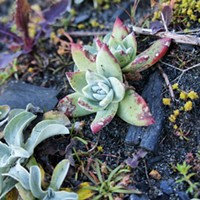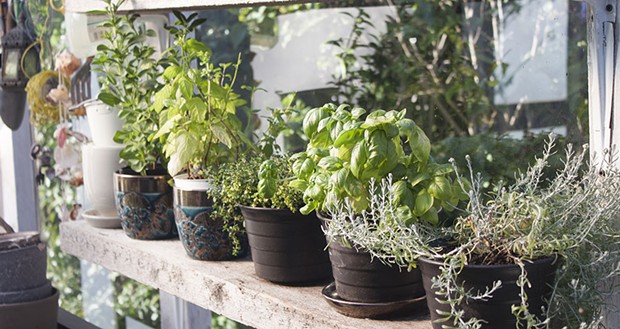[
{
"name": "Top Stories Video Pair",
"insertPoint": "7",
"component": "17087298",
"parentWrapperClass": "fdn-ads-inline-content-block",
"requiredCountToDisplay": "1"
}
]
Late summer, and the weather continues to be fine with warm days and long evenings. Here on the home farm, we're straightening up our culinary herb garden bed to enjoy stepping out the back door and snipping a few sprigs of fresh herbs to add to farm kitchen sauces, salads, soups and stir-fried veggies. Cucumbers and summer squash are going off, and we're getting ready to head to the neighborhood blackberry patch to pick as many delicious berries as possible. If you're looking for a fun and easy late summer garden project, try planting an herb garden. Most culinary herbs, such as marjoram, thyme and oregano can be planted now. Culinary herbs are easy to grow, requiring full to partial sun and occasional watering. They don't require as much legroom as veggies so they can be kept in containers and small planter boxes.
In addition to adding herbs here at home, we're helping out some neighbors with their community herb garden, too. We started with just a few containers, dollar store seeds and repurposed juice bottles for watering cans. We didn't know if anyone would actually want to garden when we weren't around, so we started small. Not only did our community members handle their fair share of daily watering, they took initiative to go out and acquire plants on their own. And manure. And tools. Before we knew it, we were admiring lush lemon cucumbers and sprawling summer squash vines taking over the back corner of the garden. The garden had taken on a life of its own. Sometimes people come and chat during the gardening hours, sometimes with their companion animals. We share friendly conversation, beautiful sunshine and the rewarding task of weeding.
The community has its fair share of problems. There's trouble with drugs, theft and loud noises at night. A good security system and an amazing property manager keep everyone following the rules. Anyone who makes trouble is asked to leave so that another individual can come in and have a chance.
Like a beautiful lotus blossom rising from the muddy bottom of a pond, this community garden is beginning to bloom in spite of its challenges. Now we're making planter boxes for succulents and culinary herbs out of donated wood scraps and glue. Everyone is starting with the same material but coming up with their own unique designs. It should make for an aesthetically pleasing display.
If you want to start a culinary herb or succulent garden of your own, late summer is a perfect time to get rolling. Go out and collect non-plastic planting containers (make sure there's good drainage in the bottom) and some seeds and/or starts (thyme, oregano, marjoram, summer savory, dill, parsley, chives, etc). Start either seeds or transplants in a container with plenty of room to grow and fast-draining, well-fertilized soil. You can place small rocks in the bottom of the 2-4 inches of the container to maximize drainage. The larger the container, the bigger your plants will go, so don't be afraid to go for jumbo sizes. In large containers, plant a few herbs together. Even medium and small containers will provide happy homes for darling plant friends. In smaller containers, plants can be planted individually. Place them in a sunny spot (indoors or outdoors) and water daily until they're well established. Add embellishments to your succulent arrangements such as rocks, crystals, feathers and sea glass to add a touch of bling. You can even move the containers depending on the season and what's flowering.
If you're unsure of what to plant, use your garden containers at as a guide. Got large containers? Go for herbs that can become large shrubs such as rosemary, sage, fennel and dill. You can also create groups of herbs to accompany a dish you love to cook — plant a cluster of spaghetti sauce herbs like basil, oregano, parsley and thyme, or mint, thai basil and cilantro for a bowl of pho. If you have medium containers, go for smaller, low growing herbs such as chives, thyme and oregano. Small containers are great for succulents to add texture to the herb garden. Succulents growing in small containers require frequent watering, which will remind you to all water the herbs. Imagine the herb and succulent garden as a microfarm with the goal of growing a harvest large enough to sustain a kitchen's worth of dried herbs (about a pint or quart-sized jar full). Each planted container has to be managed (weeded, watered and pruned). Some herbs (most especially oregano) grow faster than others, so it may be necessary to cut them back if they're grouped with other plants. Herbs' roots can be periodically pruned (every three to six months) so they don't become root bound. Cutting back roots stimulates the leaves to grow, too, so you'll be reminded to harvest as you prune with your kitchen scissors.
Katie Rose McGourty is the owner of Healthy Living Everyday at www.healthy-living-everyday.com.
Speaking of...
-

Centro del Pueblo Holds Vigil Against Hate
Jul 22, 2022 -

Bill to Protect Dudleya from Poaching on Newsom's Desk
Sep 8, 2021 -

A Sanctuary Garden
Mar 26, 2021 - More »
more from the author
-
On Becoming A Flockster
What chickens bring to your garden
- Jul 30, 2020
-
Blackouts and Enchanted Gardens
- Nov 28, 2019
-
Getting Covered and Putting up Apples
And other tasks for October harvest
- Oct 11, 2019
- More »
































